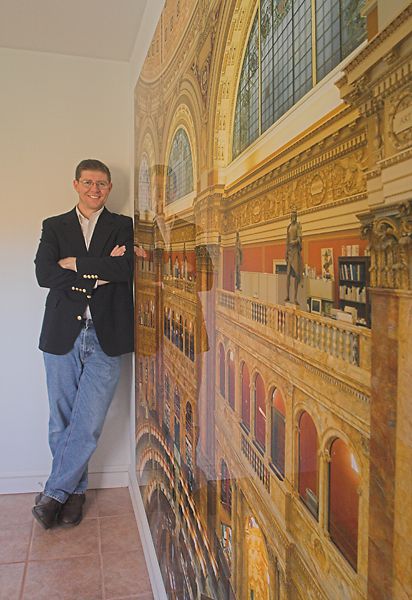Artist's Statement
Wall-sized prints challenge many of the commonly held
assumptions, and presumptions, about photography. Smaller prints -- even
those normally considered "large" by conventional standards -- present
the viewer with a "window" into another world. The viewer is
invited to look through the window, but not to step inside the scene.
Much of the impact of a scene gets diluted in the translation from reality
to print...looking at a 4x6 inch print of the Grand Canyon or the Library
of Congress interior, no matter how exquisitely composed and exposed, doesn't
produce the same emotional response as actually "being there".
Photographers have long understood this, and have been taught to employ
a variety of techniques to address this problem. The placement of
elements, the careful inclusion of curves and lines in the image,
and the positioning of visual clues to "lead the viewer's eye" into
the scene are all taught as standard methods. Among other things, these techniques
are used to help convey as much of the visual impact of the original scene
as possible in a small print.

However, large photographic prints -- and, by large, I mean prints that are 6, 9,
12 feet wide or larger -- have a fundamentally different visual and emotional
impact. Gone is the portal window through which the scene must be inspected. The
print is at least as large as the viewer (often several times as large),
and the immediate emotional response can only be described as one of "being there".
The viewer is greeted with a slightly overwhelming sense of hyper-reality...a
sense that is more to be seen than the brain knows should be possible.
Of course, wall sized images have been produced before. This is not new.
But, the clarity and detail in these images is new. And this is
what sets these images apart from other large prints, what allows
these images to be enjoyed on multiple levels, and what intrigues me as
a photographer. Stand back 20 feet from one
of these prints, and it can be viewed in its entirety...but only at a
surface level. Get up close, one foot from the print, and an entirely
new detailed picture emerges...a scene within a scene. In fact, these
pictures practically beg to be examined closely. The rules that
photographers have employed to
determine an "optimal viewing distance" for different
print sizes simply don't apply to these images. To assume otherwise is
to miss the point.
None of this is to say that the artistic measure of a photograph is its
physcial size, or that the rules of composition can all be ignored.
This is obviously false. But, photographs of this scale demand different
consideration from small prints. They can be enjoyed on a macro
level, or as a series of ever more detailed pictures within the larger
picture.
One can savor the exquisite detail in these images forever.
In February 2004, at the exhibition of my first large
print, Bryce Canyon in Utah, I conducted a little experiment. In the photograph
I captured one person...a man standing at an overlook admiring the view
of the Canyon. The man is wearing a bright yellow jacket, and stands out
quite conspicuously from the background of dark red canyon walls
and white snow...if you look in the right place. I asked viewers to
point out the man. Dozens of people looked for this yellow-jacketed
"Waldo", but nobody found him. The images are too big to be
consumed in a hurry.
I hope you enjoy your visit.